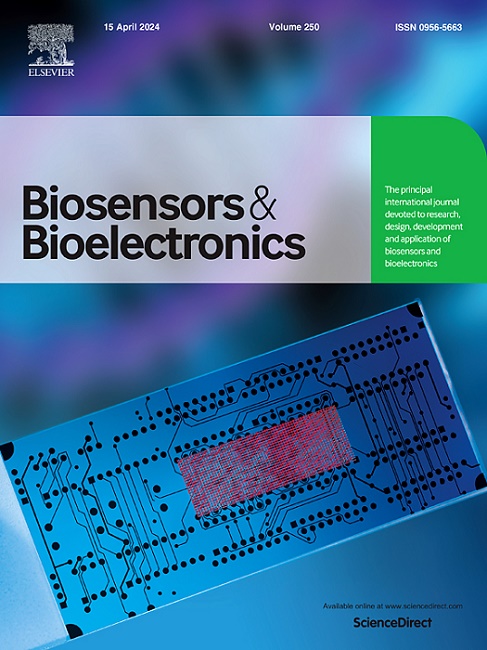NanoMIP beacons with a co-operative binding mechanism for the all-in-one detection of methamphetamine aptamer complexes
IF 10.7
1区 生物学
Q1 BIOPHYSICS
引用次数: 0
Abstract
Methamphetamine is a highly addictive stimulant with significant public health implications, necessitating the development of rapid, sensitive, and reliable detection methods. Traditional analytical techniques, though accurate, often involve complex sample preparation, expensive equipment, and lengthy analysis times. This study presents the design, synthesis, and application of nanoMIP beacons with a unique co-operative binding mechanism for the detection of methamphetamine. NanoMIP beacons selective for methamphetamine/aptamer complexes were synthesized using a solid-phase synthesis method that involved the bio-conjugation of an aptamer on the stationary phase and the incubation of methamphetamine to form a methamphetamine-aptamer complex. The resultant nanoMIP beacons were eluted off the affinity column and characterised using transmission electron microscopy. The co-operative binding mechanism, which relies on the structure-switching capability of the aptamer upon analyte binding was demonstrated through comparison of the fluorescence quenching signal of a scrambled sequence and nanoNIP controls. The fluorescence quenching assay was established using a fixed optimal concentration of aptamer and varying amounts of methamphetamine. The nanoMIP beacons showed enhanced the sensitivity (LOD = 23 ± 3.5 nM) and excellent selectivity, with a 40-fold increase in quenching for methamphetamine compared to other illicit drugs. The nanoMIP beacons demonstrated acceptable sample recoveries in both urine diluent and 50% human serum. This work provides a new strategy for the development of hybrid nanoMIP/aptamer-based sensors and provides a robust analytical tool for combating methamphetamine abuse.
具有协同结合机制的纳米 MIP 信号信标,用于一体化检测甲基苯丙胺适配体复合物
甲基苯丙胺是一种极易上瘾的兴奋剂,对公共健康有重大影响,因此有必要开发快速、灵敏和可靠的检测方法。传统的分析技术虽然准确,但往往涉及复杂的样品制备、昂贵的设备和漫长的分析时间。本研究介绍了具有独特协同结合机制的纳米 MIP 信标在甲基苯丙胺检测中的设计、合成和应用。采用固相合成法合成了对甲基苯丙胺/aptamer 复合物具有选择性的 NanoMIP 信号信标,该方法包括在固定相上生物结合aptamer,并与甲基苯丙胺孵育以形成甲基苯丙胺-aptamer 复合物。由此产生的纳米 MIP 信号从亲和柱上洗脱下来,并利用透射电子显微镜对其进行表征。通过比较乱序序列和 nanoNIP 对照组的荧光淬灭信号,证明了合作结合机制依赖于分析物结合时适配体的结构转换能力。荧光淬灭测定是使用固定的最佳适配体浓度和不同量的甲基苯丙胺进行的。nanoMIP 信标显示出更高的灵敏度(LOD = 23 ± 3.5 nM)和出色的选择性,与其他非法药物相比,对甲基苯丙胺的淬灭增加了 40 倍。纳米 MIP 信标在尿液稀释液和 50% 人血清中均显示出可接受的样品回收率。这项工作为开发基于 nanoMIP/aptamer 的混合传感器提供了一种新策略,并为打击甲基苯丙胺滥用提供了一种强大的分析工具。
本文章由计算机程序翻译,如有差异,请以英文原文为准。
求助全文
约1分钟内获得全文
求助全文
来源期刊

Biosensors and Bioelectronics
工程技术-电化学
CiteScore
20.80
自引率
7.10%
发文量
1006
审稿时长
29 days
期刊介绍:
Biosensors & Bioelectronics, along with its open access companion journal Biosensors & Bioelectronics: X, is the leading international publication in the field of biosensors and bioelectronics. It covers research, design, development, and application of biosensors, which are analytical devices incorporating biological materials with physicochemical transducers. These devices, including sensors, DNA chips, electronic noses, and lab-on-a-chip, produce digital signals proportional to specific analytes. Examples include immunosensors and enzyme-based biosensors, applied in various fields such as medicine, environmental monitoring, and food industry. The journal also focuses on molecular and supramolecular structures for enhancing device performance.
 求助内容:
求助内容: 应助结果提醒方式:
应助结果提醒方式:


